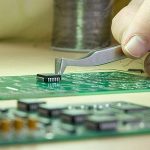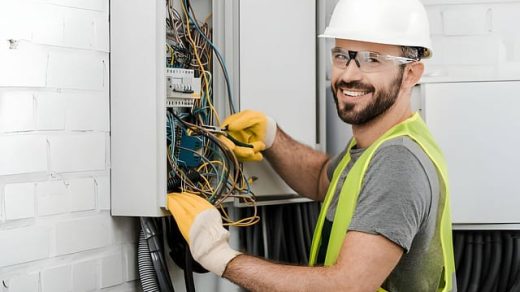The PCB manufacturing process requires a complex procedure to ensure that it delivers the desired performance. Soldering is one of the most important processes in PCB fabrication and manufacturing. It helps to attach different electronic components to the PCB, thus forming the required electrical connection. Soldering helps to populate the board with the components. The performance of any circuit is largely dependent on the effectiveness of the soldering process. The electrical contact must be robust enough to optimize the functionality of the PCB.
The PCB engineers and technicians can perform soldering in different ways. Reflow soldering uses a mixture of flux and powdered solder to attach the electrical components to contact pads, and the assembly is then heated to melt the solder and connect the joints without damaging the electrical components. Wave soldering is a bulk soldering process and requires waves of molten solder to attach metal components to the PCB. It happens through a giant oven with designated components. Manual soldering is the oldest technique to place components on the PCB. While technologies are replacing this time-consuming method, it is important to meticulously place tiny components on boards that demand high-quality standards.
To gain adequate knowledge about the best practices, trends and processes in the electronics and soldering industries, you can opt for solder training and certification. You can refer to BEST Inc., for obtaining certification in IPC soldering programs. Obtaining proper training will help you to increase the soldering quality standards, improve productivity, and hence bring better revenue and opportunities. The requisite training and certification in soldering processes play a key role in bringing value to the electronics industry. Once you complete the training program, the organization will issue an industry traceable certification to you that will help you boost your career and help you gain better career opportunities in this field.
Targeting Excellence in Soldering and PCB Manufacturing
Anyone responsible for the quality and reliability of electronic assemblies should consider obtaining the required training and certification. Along with technical knowledge, it will give them the necessary skill to perform the tasks with excellence. Appropriate training will help you to learn about the tools, processes, and various methodologies involved in the soldering process, and repair of PCBs, BGAs, and other electronic assemblies. Training equips the technician with the right knowledge to set up a “soldering work station” to effectively conduct the soldering process. Before soldering it is a good idea to have all components organized for effectively populating the PCB. The various tools may include variable temperature soldering iron, damp sponge, rosin core solder, wire cutters, pliers, de-soldering pump, safety glasses, magnifier, flux, and acid brush. You can assemble the materials beforehand, and deploy the right methods, and verification processes to efficiently solder on the circuit board.
Prevent Errors and Hazards Involved in The Soldering Process
The soldering process is complex, and hence one needs to observe certain precautions. Solder training enables technicians to deploy safety processes that could otherwise prove to be dangerous and cause injuries. Moreover, it also helps the technicians to prevent the common errors that arise during the soldering process such as underheating a pin or pad or covering it with too little or too much solder which could affect the performance of the PCB. Solder training helps to master the ideal solder joint, identify bad solder joints, spot the soldering defects, to facilitate proper soldered joints on a printed circuit board. Such ideal joints are necessary to safely conduct currents and enable the PCB to function as desired by the electronic or computing device.
Learn About the Important Soldering Tips
Solder training helps you to get the necessary information about how to make proper joints, and optimize the board performance through effective cleaning and handling. During soldering, everything should be clean and free from grease, oxidation, and contamination. In the contaminated area, the solder does not flow. Besides being clean, the soldering iron tip should also be tinned (coated with solder) which enables the solder to flow quickly on the components. Tinning the iron also prevents oxidation which increases its durability. With solder training, you can learn about the right temperature for soldering that will facilitate a good joint. Too much heat can cause excessive “sputtering” of flux, and too little can prevent the solder from melting. There are certain other parameters such as the duration of the contact of the iron with the PCB and components. It depends on the joint size and the soldering iron temperature. The right knowledge about the duration of these processes is necessary to prevent any damage to sensitive semiconductors. With appropriate training, you get the idea about adequate solder coverage that distinguishes good solder joints from bad ones. Moreover, it will enable you to properly handle the procedures to minimize any likelihood of damage.
To Conclude:
Hence, solder training helps a person to fully understand the soldering and components assembly techniques. The successful completion of training will provide you recognition and credibility, and necessary industry recognition to perform soldering and produce safe, reliable, and high-performing PCB products. Training is hence mandatory to stay up to date and retain or increase one’s soldering skills and employability.





Recent Comments